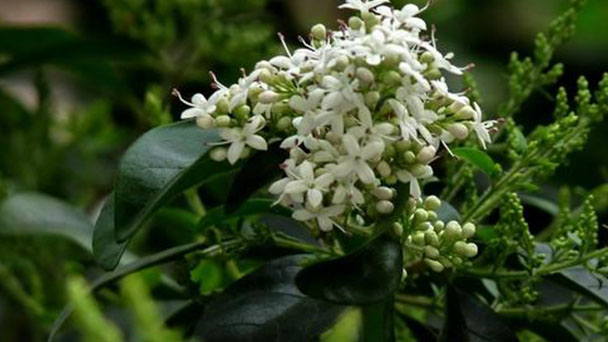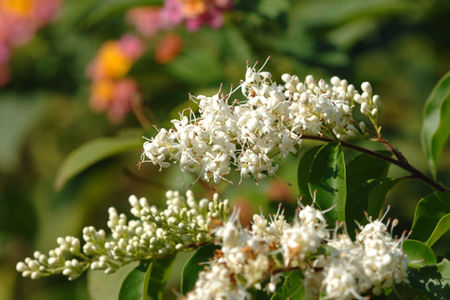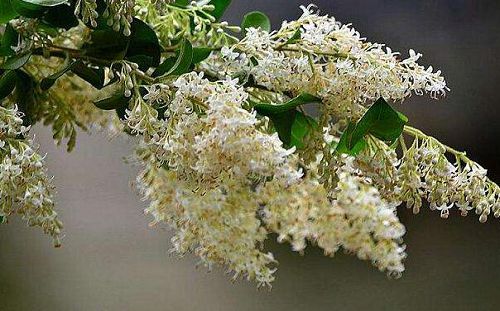Chinese privet (Ligustrum sinense) profile
Written by Maggie
Apr 01 2021

Chinese privet, scientific name Ligustrum sinense, also known as Common Privet, Japanese Privet, belongs to the Luteoceridae family. Chinese privet is a semi-deciduous small tree, up to 6 m. Branches, leaves are below midvein, inflorescence rachis densely pubescent. Leaves are simple, opposite, papery, elliptic, ca. 5 x 2 cm, entire, petiole ca. 3 mm.
Chinese privet picture

Morphological characteristics of Chinese privet
Branch
Chinese privet falls into leafy shrubs or small trees, generally about 2 meters high and up to 7 meters high. Branchlets are spreading, densely yellow pubescent.
Leaf
Chinese privet leaves are thin leathery, elliptic to elliptic oblong, 3-4.5 cm long, 1-1.8 cm wide, acute or obtuse at apex, rounded or broadly cuneate at base, surface dark green, abaxial surface pubescent only on midrib, midrib concave on surface, abaxial surface convex, lateral veins connected near leaf margin, petiole 3-6 mm long, pubescent.
Flowers
Chinese privet panicles loose, terminal, 6-10 cm long, pubescent; Flowers are white, pedicels fine, calyx campanulate, pilose, lobes linear, ca. 2 mm long, as long as calyx tube, corolla ca. 4 mm, leaves 4-lobed, lobes oblong, slightly longer than tube;Stamens 2, worn on crown tube, exerted.
Fruit
Drupe of Chinese privet is subglobose, ca. 4 mm in diameter, black.
The ecological habits of Chinese privet
Chinese privet is sensitive to soil moisture and poor growth in dry barren soil.
Chinese privet is mostly born at the edge of the village, on the hillside or in the grass. Chinese privet has entered the ranks of bonsai trees and gradually gained people's favor. However, due to the relatively thin bark of Chinese privet, in the case of poor management and insufficient water supply, the tree stump or local water loss, the old branches are easy to die, resulting in the loss of bonsai branches.

Chinese Privet propagation
Chinese Privet propagates by sowing and cutting, sowing in late autumn and cutting in spring: the suitable period for transplantation is autumn or spring, and it needs to be transplanted with soil balls.
The distribution region of the Chinese privet
Chinese privet is only found in Xi 'an Botanical Garden on the north slope of Qinling Mountains.
Chinese Privet is distributed in Jiangsu, Zhejiang, Fujian, Hubei, Hunan, Jiangxi, Guangdong, Guangxi, Sichuan, Yunnan and other provinces.
Chinese privet uses
Medicinal value
The fruit of Chinese Privet can be used to make wine, the seed can be used to make soap, and the stem bark fiber can be used to make artificial cotton. Medicinal, disturb infection, cough. Purple plant (Qifeng purple, Chinese privet) : Purple plant to treat blood, stop but not stasis, internal and external application, bleeding without worry.
Garden use
Chinese Privet is resistant to pruning and slow growing. Chinese privet has strong resistance to harmful gases, can be used for plant afforestation.Suitable for green Gracilaria, green wall and hidden shield as green screen, and can also be shaped long, short, square, round various geometric figures.

Latest Updated
- Benefits of Bugleweed - 7 Science-backed Health Benefits
- Bugleweed Dangers & Side Effects - Is It Poisonous?
- How to Plant Evergreen Trees - What You Should Know
- When to Plant Evergreens - Grow Guide for Evergreen Trees
- 12 Wonderful Evergreen Shrubs for Your Garden
- 12 Popular Evergreen Plants with Pictures for Beginners
- When And How To Prune A Lilac Bush Like a Pro
- How to Grow & Care for Lilac Vine (Hardenbergia Violacea)
- Japanese Lilac Tree (Syringa Reticulata) Care & Propagation Guide
- Shumard Oak Pros and Cons - What to Know
Popular Articles
- Winter maintenance of Antirrhinum Majus
- How to Grow Terminalia Mantaly Tree
- How to Grow and Care for Crossostephium Chinense
- How to grow Antirrhinum Majus in spring
- Peristeria Elata (Dove Orchid) Profile: Info & Care Guide
- Underwatered Snake Plant (Sansevieria Trifasciata) - Signs And How To Fix
- How to Care for Brazilian Jasmine Plant (Mandevilla Sanderi)
- How to Grow & Care for Graptopetalum Purple Delight in Summer
- Rosa Chinensis (China Rose): Plant Growing & Care Tips
- How to Care for Baby Sun Rose (Aptenia Cordifolia)